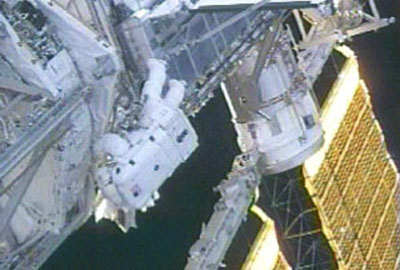Another headache the ISS doesn’t needby Taylor Dinerman
|
| This repair operation is important since it will directly affect the life span of the ISS. If the SARJ can be repaired permanently, it will demonstrate that similar problems can be managed by future crews. |
For the time being NASA calculates that the solar array in place will be able to handle the power demands of the expanding station. The next flight, Discovery’s STS-124, now scheduled to launch on May 31st, will carry the largest segment of Japan’s Kibo module. Once installed, this will begin to strain the capabilities of the system as it now exists. Certainly none of the serious scientific work planned for both Kibo and for Europe’s Columbus segment will be able to take place until the ISS’s electrical problems are sorted out.
During the first of the mission’s three spacewalks they plan to install a new Trundle Bearing Assembly in place of the one that was removed for inspection last December. They will also be testing a possible repair technique that consists of covering the damaged track of the SARJ with lubricant and then scraping off the grit (called “pancakes”). If this works then future ISS crews will probably have to spend many long hours in space scraping the inside of the SARJ. Not a pleasant prospect.
This repair operation is important since it will directly affect the life span of the ISS. If the SARJ can be repaired permanently, it will demonstrate that similar problems can be managed by future crews. If the repairs are merely stopgap measures, though, this will show that the effort needed to keep the station’s systems operational is greater—perhaps much greater—than expected. This means in turn that as time goes on and various elements age it will be harder and more expensive to keep up with unexpected maintenance requirements.
In any case, the lessons from this incident will be applied to future large space structures including ones that will be part of a future lunar outpost. One lesson is that large systems with moving parts such as the SARJ must be designed so that they are as robust as possible and, at the same time, they must be easily repaired. One of the virtues in the SARJ design was that astronauts were able to remove covers and inspect inside without too much difficulty.
NASA has at least until December of this year to fix the SARJ. That is when they plan to launch the fourth and final set of solar arrays for the station. In theory, then, there is plenty of time for scraping and cleaning. However, there is already a packed schedule for the ISS crews and it may be unsafe to push them to do more. There is also the question of training Russian cosmonauts to carry out repairs on an American system. This will have to be carefully planned, but Russians have traditionally shown themselves to be adaptable and with a little bit of goodwill on all sides this should not be a problem.
What may be more difficult will be to plan for the replacement of the current generation of arrays. If the ISS is going to last until 2020 or 2025 it will need a new set of solar wings. Drastically improved photovoltaic technology is already here and by the time the new arrays will be designed and manufactured the state of the art will be even further advanced. The challenge will not be to build the new system, but to find a way to launch it without the shuttle. Any future design will have to make maximum use of parts that are already on orbit and it will also have to be easily deployed with a minimum of human time and effort.
| It is almost a quarter century since Ronald Reagan set the program in motion, but in spite of all the difficulties and heartbreaks the ISS is, without question, a major achievement. |
For all its flaws, the ISS has been, and will continue to be, mankind’s one and only outpost in orbit. Onboard, people are learning to work and survive in orbit. There have now been seventeen expeditions to the station. By time the program ends—one hopes not for another two decades—enough humans will have visited it to fill a fair-sized hotel. The US Congress designated it a national laboratory, so far with no discernible results, but this will change. When the station’s racks are full of experiments and there is a full six-person crew on board, the results may, perhaps, impress at least some of the skeptics.
Building the ISS has taken far longer than planned. It is almost a quarter century since Ronald Reagan set the program in motion, but in spite of all the difficulties and heartbreaks it is, without question, a major achievement. It is way, way over budget, it’s in the wrong orbit, and it may never produce the scientific breakthroughs that were promised, but it is the only space station we have. Let’s cherish it.
